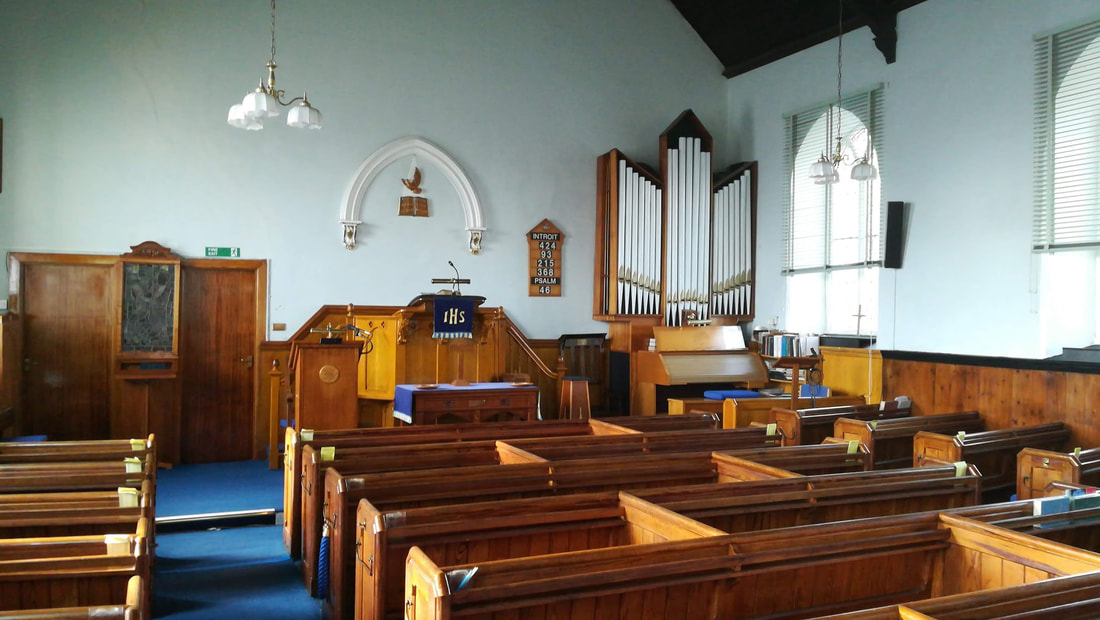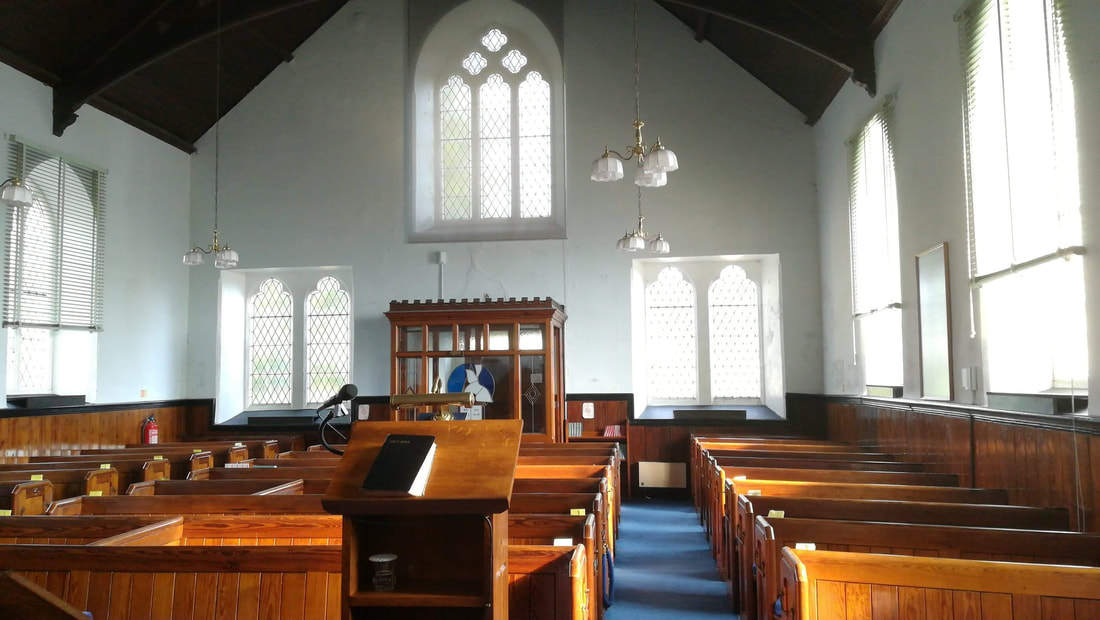|
Minister: Rev Prof. John Heywood Thomas DD (URC)
Contact: Glyn Hoskins - 01446 760457 Secretary: Glynis Owen - 02920 842630 Services: Sundays, 11am The Chapel has a meeting room that's available for hire. |
Trehill was one of the first Methodist churches in Wales, established in 1740. The congregation was founded at the personal invitation of Howell Harris, the charismatic leader of the 18th century Welsh Methodist Revival and founder of the Presbyterian church of Wales.
The following text is from the church's leaflet by Jean Evans. Trehill is a living Church and although it venerates all the old traditions linked with it, it lives in the present. In 2002, the church decided to add a little memorial garden, just to the right of the main entrance, for the burial of ashes of those close to the church. Marked out with a simple white painted chain, it already holds several memorial tablets |
An Early Call To Trehill
The Methodist Revival in Wales started with the conversion of Welsh icon Howel Harris in 1735, the time from which the Presbyterian Church in Wales still dates its origin.
Today, the Presbyterian Church of Wales No is Nonconformist but Howell Harris, like the Wesley brothers and most Methodists, was a staunch member of the Established Church. The Methodists vision was to reform the church from within, not divide it.
Howell Harris organised his followers to groups called 'Societies', never a 'Church' . Trehill started life as a Methodist Society within the nearby Anglican Church of St. Nicholas.
It was more than a generation after the death of Howell Harris that Welsh Methodists broke away from the Established Church in 1811 to become Nonconformist as the Calvinistic Methodist Church. It was in the 1930s that it changed its name the Presbyterian Church of Wales.
Trehill was an early Society formed, as the personal invitation of Howell Harris, in 1740. Today, a plaque at the best re-entrant promo proclaims that honour.
Howell Harris had a special relationship with the fellowship here. He visited So the Society 23 times and it became an important centre of Methodism.
The present church was built in 1870.
Harris Chooses Trehill
When the Great Separation divided Welsh Methodist into Harris's people and Rowland's people, it was at Trehill that Harris chose to hold the first Methodist Association for his followers in 1750.
Trehill was, therefore, the scene of one of the great historic events of Welsh Methodism, giving it another unique association with its iconic founder.
It was at that Association that Harris saw the fulfilment of his ambition to have a Madam Sydney Griffith, his spiritual companion whom he saw as a prophetess, formally declared to be a 'Mother in Israel' - a mark of great honour.
Soon after, Madame Griffith died unexpectedly.suffering her last and broken in body and spirit from his exertions for the Revival, Harris withdrew from the Methodist movement and retired to his home in Trefeca.
there, with the help of his wife and, he began to build the self-sufficient religious community known as they 'Trevecka Family'. Among those who joined him was the young Anne Gibbon from the Trehill Society. She died the following year, still only 18.
Harris's relationship with Madame Griffithwas controversial but he, unfailingly, maintained it was spiritual. Clearly, the other Welsh leaders believed him absolutely.
Otherwise, Daniel Rowland and Williams Pantycelyn, the great hymnist whose Bread of Heaven chorus still resounds at Welsh rugby internationals, would not have welcomed him back for a second, long sustained, period of the Welsh Methodist Revival.
Revival flames through the World - and Wales
The Methodist revival in the 18th century as a vast international movement sparked spontaneously in different countries across the world. the country spawned its own great leaders. In England, the renowned John Wesley emerged as a leader. In Wales, it was the charismatic Howell Harris, a young man who lived in Trefeca, mid-Wales.
But the massive canvas of international Methodism was made up of a myriad small local causes' where ordinary people worked and witnessed together. Such a one was Trehill. The story of Howell Harris and of Welsh Methodism, writ small, is reflected in the life of this one church.
It was hard to be methodist. they suffered great prejudice and violence. They were often ridiculed outcasts of society. Methodists were still part of the established Church but the Church was increasingly harsh against them. Yet the Revival spread.
Harris was tireless in his zeal. In one period of nine weeks, he visited 13 countries, travelling some 150 miles a week on horseback - with, as he famously said, #0 Welsh miles equal to 30 English miles!
Before their children were born, his wife Anne often travelled with him.after a snowstorm, he wrote in his diary of the pair, 'happily singing together though it did snow and blow most sorely'.
typical of the time, the couple lost children to death. The first died soon after birth, death then Anne delivered a healthy girl who was named after her. The only child to survive to adulthood, however, was their third child, Elizabeth. The young and died of smallpox shortly after her second birthday.
As he travelled, Howell Harris established societies'. Groups who met together for spiritual care. On a larger canvas, Methodists from all over Wales came together at great meetings called Associations.
At Watford Association in 1743, the major decision was taken that Methodists would not leave the Established Church. On a local note, John Deer and Richard Jones, were 'settled' as leaders at Trehill.
Harris had continuing, intimate relations with the Societies he formed. They wrote to him and he wrote to them. Trehill letters mirrored the major dramas of Welsh Methodism.
Theological conflict between Calvinism of Harris and the Arminianism of Wesley were mirrored when John Deer, hostile to a visit of Methodist hymn writer Charles Wesley, wrote ominously: 'I need not tell you what doctrine he do preach!'
When Harris joined the Brecon Militia to defend a Protestant king against a Catholic invasion from France during the Seven Years War, Richard Jones left Trehill to join him.
Howell Harris was a volatile, tempestuous man and quarrelled periodically with all the Methodist leaders, Daniel Rowland and William Williams. Pantycelyn led to what is called the Great Separation.
Welsh Methodism split into Rowland's people and Harris's people. Soon after, Harris retired to Trefeca. Reconciled in 1762, he was back in Trehill, riding his famous chaise and two horses with the words 'God is my peace' emblazoned on the side.
Ministers at Trehill
When Welsh Methodists became a Nonconformist Church in 1811, Trehill continue to depend on itinerant preachers for a century. It gave not call its first minister until 1909.
Rev John Owen Evans 1909-1940
Rev Albert Edward Roberts 1944-1963
Rev james Hamilton Hawkins BA 1964-1975
Rev John Selwyn Roberts BA (URC) 1976-1979
Rev John Calvin Thomas 1980-1987
Rev Gwilym Evans BA BD 1988-1989
Rev Elfred Griffith Williams BA BD 1990-2004
Rev Prof John Heyward Thomas DD (URC) 2005-


